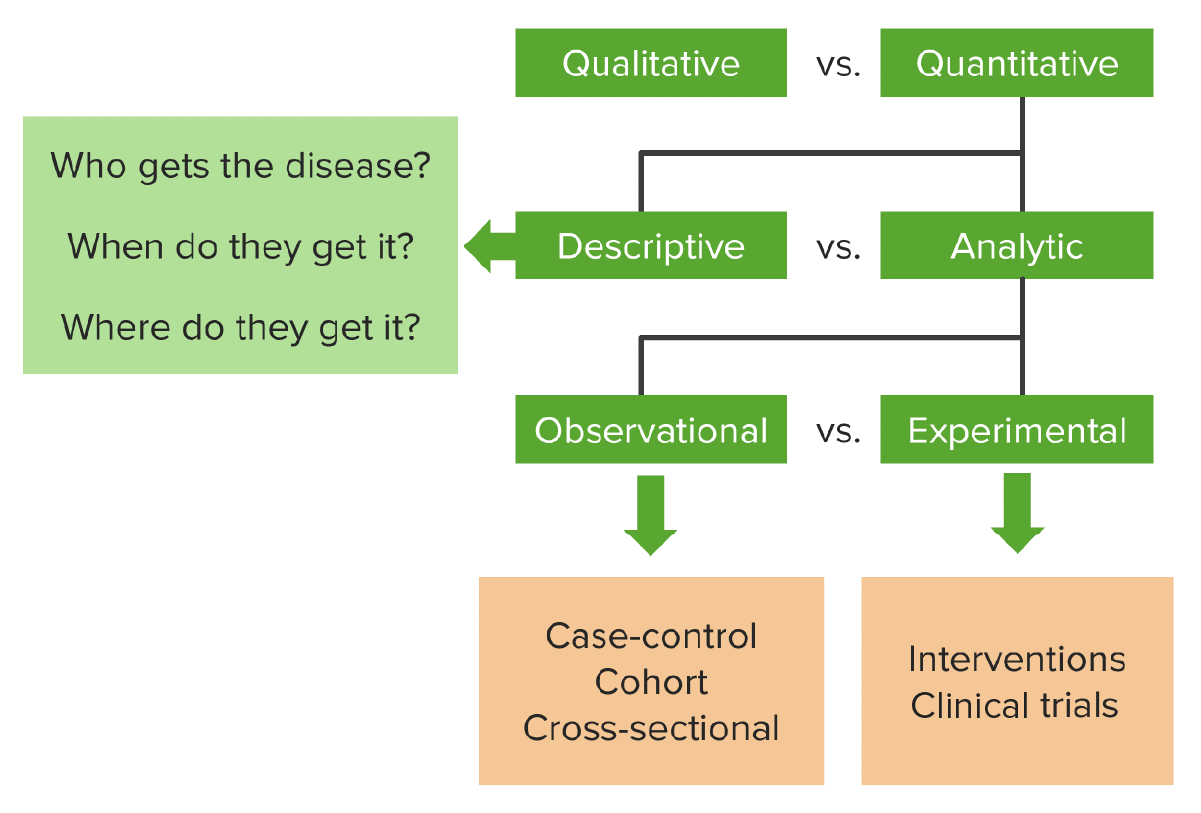Playlist
Show Playlist
Hide Playlist
Cohort Study – Observational Studies (Study Designs)
-
Slides 07 ObservationalStudies Epidemiology.pdf
-
Reference List Epidemiology and Biostatistics.pdf
-
Download Lecture Overview
00:01 Case-control studies are susceptible to that kind of bias if you select the controls inappropriately. 00:06 Now let's look at the cohort study, using the same example of smoking and lung cancer. 00:11 In the case of the cohort example we ascertain the exposure first and then we look forward in time to see who gets the outcome, in this case lung cancer. So the direction chronologically of the inquiry is going to be forwards in time, remember the case-control looks backwards in time, cohort looks forward in time. We begin by finding individuals who smoke, some individuals who don't smoke or some other kind of exposure and we wait as time passes to see who gets the outcome and who doesn't have the outcome. Now from the cohort example, we can compute incidence rates because I didn't select these individuals, I just watched them and saw how they started their behaviors. And then I saw if the outcome manifested on its own naturally, that's a true incidence rate. So cohort designs allow us to compute incidence rates, case controls do not. That's an important consideration when we attempt to measure actual ratios of association. So remember, the direction of inquiry in a cohort study is to look forward in time and in our lung cancer smoking example we begin by finding some smokers and finding some people who don't smoke and waiting until some of them develop cancer and we compare the proportions of those who get cancer in the smoking group to those who get cancer in the non-smoking group. The cohort study has a lot of advantages; the first obvious advantage is, we can compute incidence rates. That's huge. We love that. It's very important. 01:44 Next is that we can yield more information on the incidence of other kinds of diseases. 01:49 So we can look at a variety of things that may manifest from my exposure. We have a clear temporal relationship between exposure and disease, I know that smoking came before the cancer, remember in our cross-sectional example, I didn't have that ability because I was ascertaining exposure status and outcome status simultaneously. In the cohort example I know for a fact the smoking came before the lung cancer because I saw it happen. And lastly we can measure rare exposures using the cohort study. Think about it, let's say something is really rare, like doing a certain activity, walking on the moon, traveling in space, I don't know, think of a variety of things you could probably think of that are rare. I can select those individuals, find some people who didn't have those experiences and then wait in time to see if certain diseases manifest. Other advantages include that the cohort study allows us to look at a variety of exposures, I can look at smoking, I can look at eating behaviors, where you live, all in the same study pool. I can look at multiple outcomes of a particular exposure as well if I choose to. I can minimize bias by choosing my individuals carefully, I have a lot of control here. It's also the strongest design in the observational category for establishing cause-and-effect, I can't really establish cause-and-effect, for reasons that I will discuss when we talk about experiments, but to the extent that observational studies are able to offer a degree of wisdom, cohort studies are the best. 03:29 So the disadvantages though are quite extreme. It's quite time-consuming. If I have to wait to see if someone develops cancer from smoking, I'm going to wait years, if not decades, possibly a lifetime. So it's not particularly useful in that sense, therefore it can be expensive. 03:45 Often it requires a large sample size, because maybe my outcome that I care about is only manifesting in a certain small percentage of the cases of individuals who engage in this behavior, so I need a lot of people doing this behavior before a certain outcome will manifest. Let's say 0.1% of smokers developed lung cancer, I just made up that number, don't look it up. In that case I'll need a great many smokers to study to get even a single case of lung cancer manifesting. And as I mentioned, all this can be quite expensive. Other disadvantage is, we can't really measure rare diseases using a cohort study. Think about that, if my disease is quite rare I may wait forever for it to manifest if I'm looking at it in a prospective, forward in time process. I may have a lot of losses to follow up. 04:38 In our lecture on biases, we learned that loss to follow-up is a major consideration, so is I'm following a bunch of people through time, perhaps years, perhaps decades, I'm going to lose a fair amount, most likely. And lastly, changes over time in how I'm ascertaining an outcome may in fact lead to some biases as well. So maybe when I started my study, I had a certain test for determining if you get the disease I'm interested in. Let's say it's not lung cancer, let's say it's something cognitive, psychological test, a quiz maybe, and five years later, some psychologists develop a better test that I could've used and I introduce that test halfway through my study, I've now created a real problem in my study, because I've changed the way that I diagnose my outcome. So that's always something we try to look to and control if we can. 05:25 I want to talk a little bit now about the verbiage we use to talk about the flow of time, prospective and retrospective. These terms refer to the time frame, not necessarily the direction of inquiry, but the timeframe. The direction of inquiry describes when I'm going to get my exposure versus my outcome, but the timeframe is how in real time I'm going to conduct my study. So prospective study moves forward in time. We have other words for it as well, longitudinal studies or concurrent studies. Some people say cohorts are naturally longitudinal or concurrent. Retrospective on the other hand means backwards in time, other words to use it, historical or non-concurrent. So a cohort study is typically prospective, we begin by looking at exposure statuses and we move in forward in time to see if there's an outcome. Is there such a thing as a retrospective cohort? Yes there is, this would confuse a lot of people, but it isn't that difficult to understand. A retrospective cohort is the opposite of a prospective cohort. In a prospective cohort, you ascertain the exposure status and you wait to see if the outcome manifests. In a retrospective cohort, you do this in the past, using historical records. I look up medical records in a certain hospital, I find some individuals who had an exposure, I look forwards to the medical records to see if they manifested an outcome. It's still moving forwards in time, but it happened in the past. That's what makes it a retrospective cohort.
About the Lecture
The lecture Cohort Study – Observational Studies (Study Designs) by Raywat Deonandan, PhD is from the course Types of Studies.
Included Quiz Questions
Which of the following is a disadvantage of a cohort study?
- It is time-consuming.
- It is the strongest observational design for establishing cause and effect relationships.
- It minimizes bias.
- It allows one to calculate incidence rates.
- It gives a clear temporal relationship between exposure and disease.
Which of the following is an advantage of a cohort study versus a case-control study?
- A cohort study can calculate incidence rates.
- A cohort study is more cost-effective.
- A cohort study is less time-consuming.
- A cohort study can only look retrospectively at data.
- A cohort study is efficient for studying rare diseases.
Which of the following terms is a temporal descriptor for a study that follows subjects forward in time?
- Prospective
- Retrospective
- Straightforward
- Case-control
- Complicated
Customer reviews
5,0 of 5 stars
| 5 Stars |
|
5 |
| 4 Stars |
|
0 |
| 3 Stars |
|
0 |
| 2 Stars |
|
0 |
| 1 Star |
|
0 |




